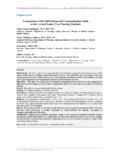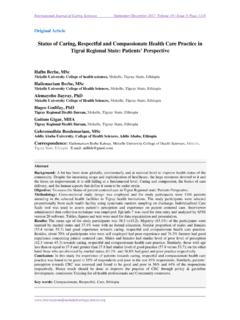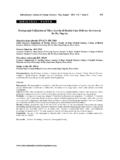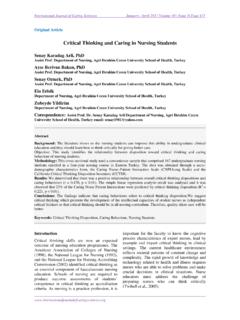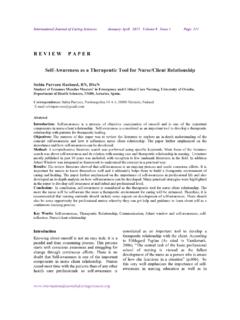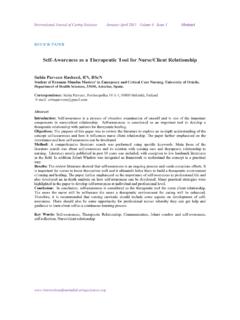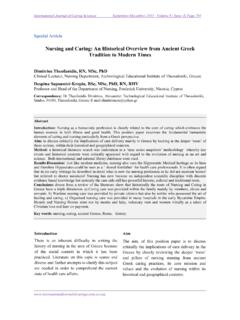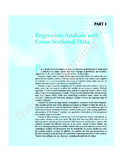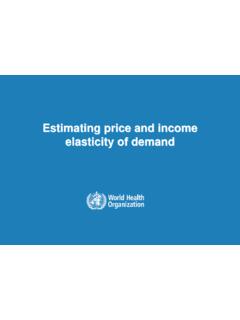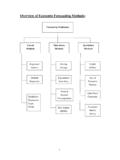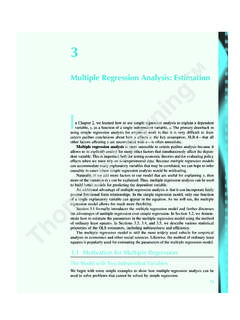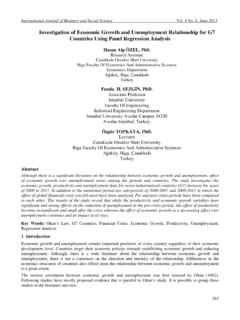Transcription of Prevalence and Determinants of …
1 International Journal of Caring Sciences September December 2016 Volume 9 | Issue 3| Page 827 Original Article Prevalence and Determinants of Overweight/Obesity in Adolescents: A Cross-Sectional Study in Greece Despoina Fragkou, MSc Economist, University of Piraeus, Department of Economics, Piraeus, Greece Petros Galanis, RN, MPH, PhD University of Athens, Department of Nursing, Center for Health Services Management and Evaluation, Athens, Greece Pantelis Pantelidis, PhD Professor, University of Piraeus, Department of Economics, Piraeus, Greece Correspondence: Despoina Fragou, 123 Papadiamantopoulou street, GR-11527, Athens, Greece e-mail: Abstract Background: Prevalence of childhood obesity has increased remarkably turns into a big problem in developed world, affecting significantly the physical and the emotional health of children.
2 Objective: To estimate the overweight/obesity Prevalence of children 10 to 15 years-old and to find out the Determinants of this disease. Methodology: We conducted a cross-sectional study on 306 children 10 to 15 years-old in elementary and intermediate schools in Larissa, Greece. Selection of schools was performed in a random way with the use of a table of random numbers and response rate was (306 out of 352). Data collection was performed during May 2015 and the children were classified as underweight, normal, overweight and obese according to body mass index, gender and age. The Determinants under study were demographic characteristics, internet use, personal computer use, television watching, nutritional habits, physical activity, sleeping habits and attitudes towards diet issues.
3 Data analysis was performed with IBM SPSS Results: Seventy-seven point five percent of the children were classified as normal, as overweight, as underweight and as obese. In particular, of the boys and of the girls were overweight, while of the girls and 0% of the boys were obese. Mean body mass index of children was Multivariate logistic regression analysis identified that boys, children with television in their room and children who used personal computer/video games machines/mobile/tablet were more overweight/obese. Conclusions: Appropriate health policies should be implemented in order to decrease obesity among children based on the Determinants of this disease.
4 Keywords: body mass index, children, Determinants , obesity, overweight, Prevalence . Introduction Childhood obesity turns into a big problem in developed world, affecting significantly the physical and the emotional health of children. Also, morbidity and premature death in the adult life are higher among obese children. Factors that affect children's weight and fat distribution include environmental and genetic characteristics since Prevalence of overweight and obesity are different in populations with similar lifestyle. Background During the last 50 years, Prevalence of childhood obesity has increased remarkably, especially in developed industrial areas (Lobstein, 2010; Wang & Lobstein, 2006; Wang & Zhang, 2006).
5 In that case, Prevalence of overweight and obesity among 5 to 17 years-old children is International Journal of Caring Sciences September December 2016 Volume 9 | Issue 3| Page 828 for boys and for girls (Organization for Economic Co-operation Development, 2011). Prevalence of overweight and obesity in children varies among countries of Organization for Economic Co-operation and Development (OECD), with the higher Prevalence to be in Greece (40%) and the lower in Korea, Turkey and China ( to 16%) (Organization for Economic Co-operation Development, 2011). A recent systematic review find out that the childhood obesity in Greece is increasing during the last 30 years (Roditis et al, 2009).
6 Studies in Greece found that Prevalence of overweight and obesity in children is among 30 to 40% (Krassas et al, 2001; Magkos et al, 2006; Janssen et al, 2006; Papadimitriou et al, 2006). In 2011, a cross-sectional national study including 6 to 12 years-old children found that Prevalence of obesity for boys was and for girls (Tzotzas et al, 2011). There are a great number of papers and systematic literature reviews about the Determinants of childhood obesity (Monasta et al, 2010; Mistry & Puthussery, 2015; Hebebrand & Hinney, 2008; Kipping et al, 2008). Concisely, Determinants could be summarized as demographic characteristics, watching television, personal computers and internet use, eating habits, physical activity, sleeping habits, family attitudes and genetic factors.
7 Aim The increasing Prevalence of childhood obesity and the following problems in mature life of children and in the public health demand more studies in this scientific area in order to clarify the Determinants of childhood obesity. For that reason, we conducted this study in order to estimate the Prevalence of obesity in 10 to 15 years-old children and to found out the Determinants of childhood obesity. Methodology Participants We conducted a cross-sectional study in Larissa, Greece, during May 2015. Larissa is a high-density (7,733 residents per km2) urban city surrounded by a network of suburbs and villages, with 146,926 residents at the time of study (National Greek Survey, 2011).
8 Study was conducted in three elementary schools and one intermediate school. Selection of schools was performed in a random way with the use of a table of random numbers. All children attending the last two classes in the elementary schools and all classes in the intermediate school were invited to participate in the study. Response rate was (306 out of 352). Design A pilot study with 30 children was conducted prior to the final study and face validity of the questionnaire was confirmed. In particular, children did not meet difficulties in the completion of questionnaire and they did not report any vaguenesses or errors in expression of questions.
9 Unfortunately, a great number of children (28 out of 30) denied to measure their weight and height on a standardized equipment by the researchers (bathroom scale and aluminum anthropometer), but all children accepted to self-estimate their weight and height. So, in order to increase the response rate in the final study we decided to permit children to self-estimate their weight and height rather than to do these measurements on a standardized equipment. Ethical considerations First of all, we informed children and their parents (or their guardians) oral and written about the study and after a week we invited children to complete voluntary an anonymous, self-reported questionnaire.
10 Children and their parents were assured of the anonymity and strict confidentiality of their responses and that children could withdraw from the study any time. Also, we informed children that the questionnaire was not an examination and that there were no right or wrong answers. In that way, we assured the informed consent of students in our study. With the assistance of teachers, we distributed the questionnaires to the children during classroom hours. The questionnaires were returned in sealed envelopes to ensure confidentiality, while the questionnaires and the envelopes did not require any means of identification.

